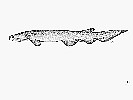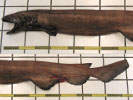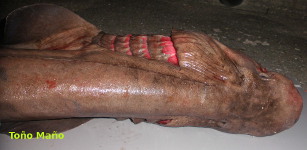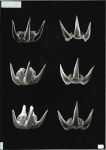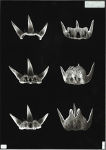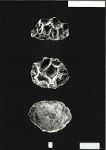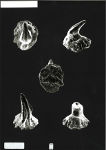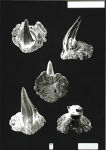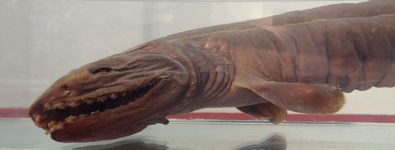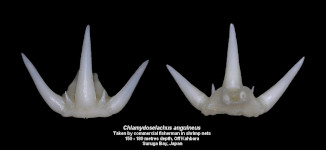Chlamydoselachus anguineus
Garman, 1884
Frilled shark
Classification: Elasmobranchii Hexanchiformes Chlamydoselachidae
Reference of the original description
An extraordinary shark. Bulletin of the Essex Institute, 16, 47–55
An extraordinary shark. Bulletin of the Essex Institute, 16, 47–55
Synonyms / new combinations and misspellings
Chlamydoselache anguinea, Chlamydoselachus anguineum, Chlamydoselachus cf. anguineus
Chlamydoselache anguinea, Chlamydoselachus anguineum, Chlamydoselachus cf. anguineus
Description :
Citation: Chlamydoselachus anguineus Garman, 1884: In: Database of modern sharks, rays and chimaeras, www.shark-references.com, World Wide Web electronic publication, Version 11/2024
Please send your images of "Chlamydoselachus anguineus" to info@shark-references.com

Chlamydoselachus anguineus Garman, 1884, 177 cm female caught at a depth of 695 m some 12 miles off the coast of Galicia in a gillnet; © Toño Maño, Tiburones en Galicia, Spain

Chlamydoselachus anguineus Garman, 1884, 177 cm female caught at a depth of 695 m some 12 miles off the coast of Galicia in a gillnet; © Toño Maño, Tiburones en Galicia, Spain
Common names
 Kragenhai,
Kragenhai,  Krausenhai,
Krausenhai,  Tiburón anguila,
Tiburón anguila,  Tiburón anguilla,
Tiburón anguilla,  Requin lézard,
Requin lézard,  Frill shark,
Frill shark,  Frill-gilled shark,
Frill-gilled shark,  Frilled shark,
Frilled shark,  Greenland shark,
Greenland shark,  Scaffold shark,
Scaffold shark,  Silk shark,
Silk shark,  Squalo serpente,
Squalo serpente,  Cobra,
Cobra,  Tubarao,
Tubarao,  Tubarão-cobra
Tubarão-cobra
 Kragenhai,
Kragenhai,  Krausenhai,
Krausenhai,  Tiburón anguila,
Tiburón anguila,  Tiburón anguilla,
Tiburón anguilla,  Requin lézard,
Requin lézard,  Frill shark,
Frill shark,  Frill-gilled shark,
Frill-gilled shark,  Frilled shark,
Frilled shark,  Greenland shark,
Greenland shark,  Scaffold shark,
Scaffold shark,  Silk shark,
Silk shark,  Squalo serpente,
Squalo serpente,  Cobra,
Cobra,  Tubarao,
Tubarao,  Tubarão-cobra
Tubarão-cobra
Short Description
Eel-like shark with 6 gill slits, the lower ends of the first gill slits connected t each other across throat [518]. Dark brown or grey in color, sometimes paler below [578]. Dorsal fin small and lobe-like originating over pelvic fin bases to behind anal fin origin [1388]. Anal fin larger than dorsal fin [1388]. Pectoral fins small and paddle-shaped [1388]. Caudal fin with weak ventral lobe and without subterminal notch [1388]. Terminal mouth with tricuspid teeth in both jaws [518].
Eel-like shark with 6 gill slits, the lower ends of the first gill slits connected t each other across throat [518]. Dark brown or grey in color, sometimes paler below [578]. Dorsal fin small and lobe-like originating over pelvic fin bases to behind anal fin origin [1388]. Anal fin larger than dorsal fin [1388]. Pectoral fins small and paddle-shaped [1388]. Caudal fin with weak ventral lobe and without subterminal notch [1388]. Terminal mouth with tricuspid teeth in both jaws [518].
Distribution
Wide-ranging but with patchy distribution. Western Indian Ocean: off South Africa. Western Pacific: off Japan to New Zealand. Eastern Pacific: southern California, USA to northern Chile. Eastern Atlantic: northern Norway to northern Namibia, possibly the eastern Cape of Good Hope, South Africa. Three specimens have been recorded from the western Atlantic [2445]. Source: www.gbif.org
Wide-ranging but with patchy distribution. Western Indian Ocean: off South Africa. Western Pacific: off Japan to New Zealand. Eastern Pacific: southern California, USA to northern Chile. Eastern Atlantic: northern Norway to northern Namibia, possibly the eastern Cape of Good Hope, South Africa. Three specimens have been recorded from the western Atlantic [2445]. Source: www.gbif.org
Human uses
fisheries: minor commercial; price category: not marketed/unknown; price reliability:
fisheries: minor commercial; price category: not marketed/unknown; price reliability:
Biology
Ovoviviparous, embryos feed solely on yolk [733]. Number of young 2 to 15 [19900]. Gestation period is probably very long, one to two years (Ref. 39551). Size at birth 40-60 cm [1388]. Distinct pairing with embrace [17086]. An uncommon primitive shark [578] found on outer continental and insular shelves and upper slopes, usually between 120 and 1,280 m but occasionally caught at the surface [518]. Feeds on other sharks, squid and bony fish [578].
Ovoviviparous, embryos feed solely on yolk [733]. Number of young 2 to 15 [19900]. Gestation period is probably very long, one to two years (Ref. 39551). Size at birth 40-60 cm [1388]. Distinct pairing with embrace [17086]. An uncommon primitive shark [578] found on outer continental and insular shelves and upper slopes, usually between 120 and 1,280 m but occasionally caught at the surface [518]. Feeds on other sharks, squid and bony fish [578].
Remarks
shark-references Species-ID=1453;
shark-references Species-ID=1453;
Parasites (arranged by Jürgen Pollerspöck)
Cestoda
Nematoda
Cestoda
- Hepatoxylon trichiuri (Holten, 1802) [16112]
- Monorygma chlamydoselachi Lönnberg, 1889 [19896] [16443]
Nematoda
- Mooleptus rabuka (Machida, Ogawa & Okiyama, 1982) [31368]








